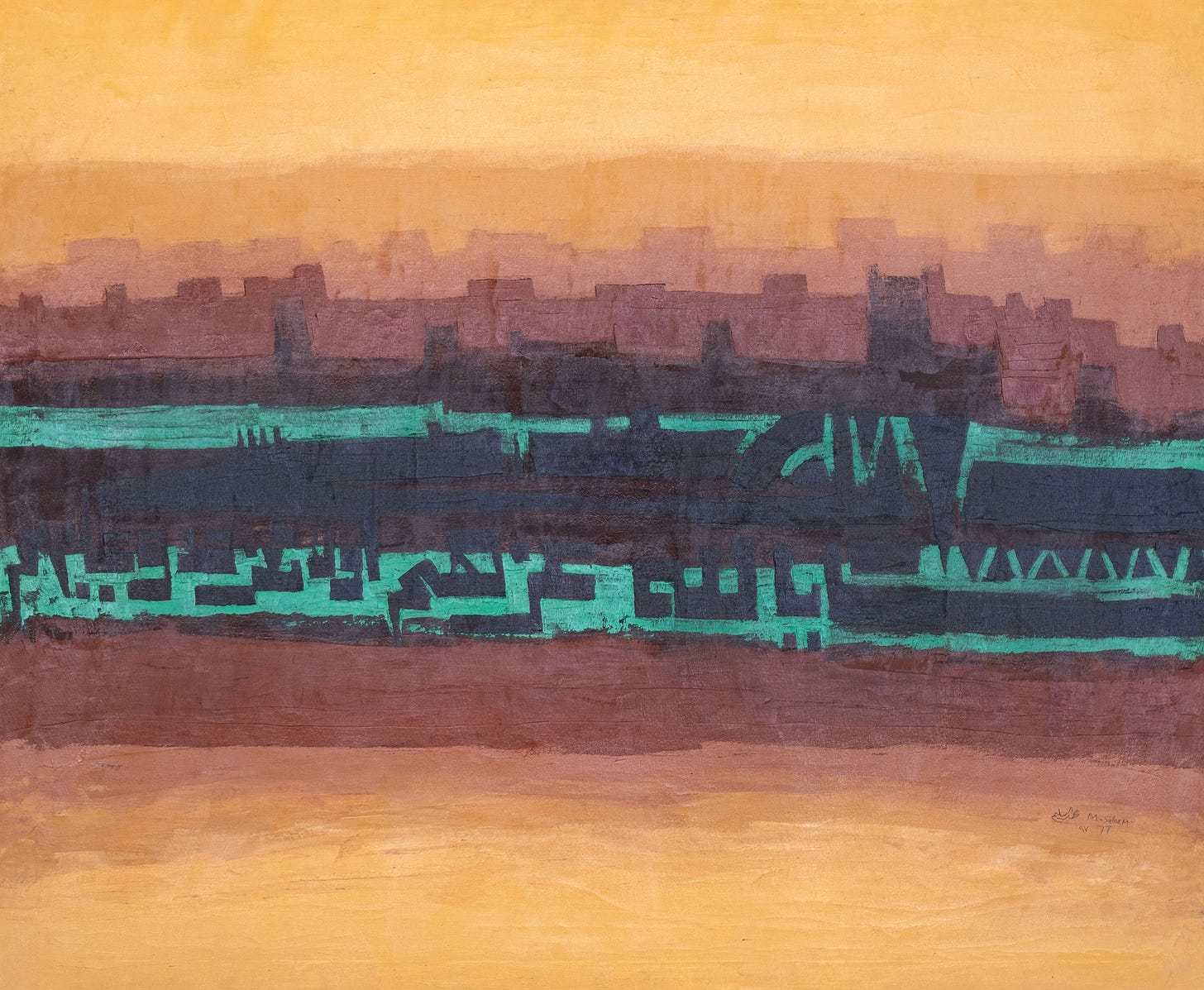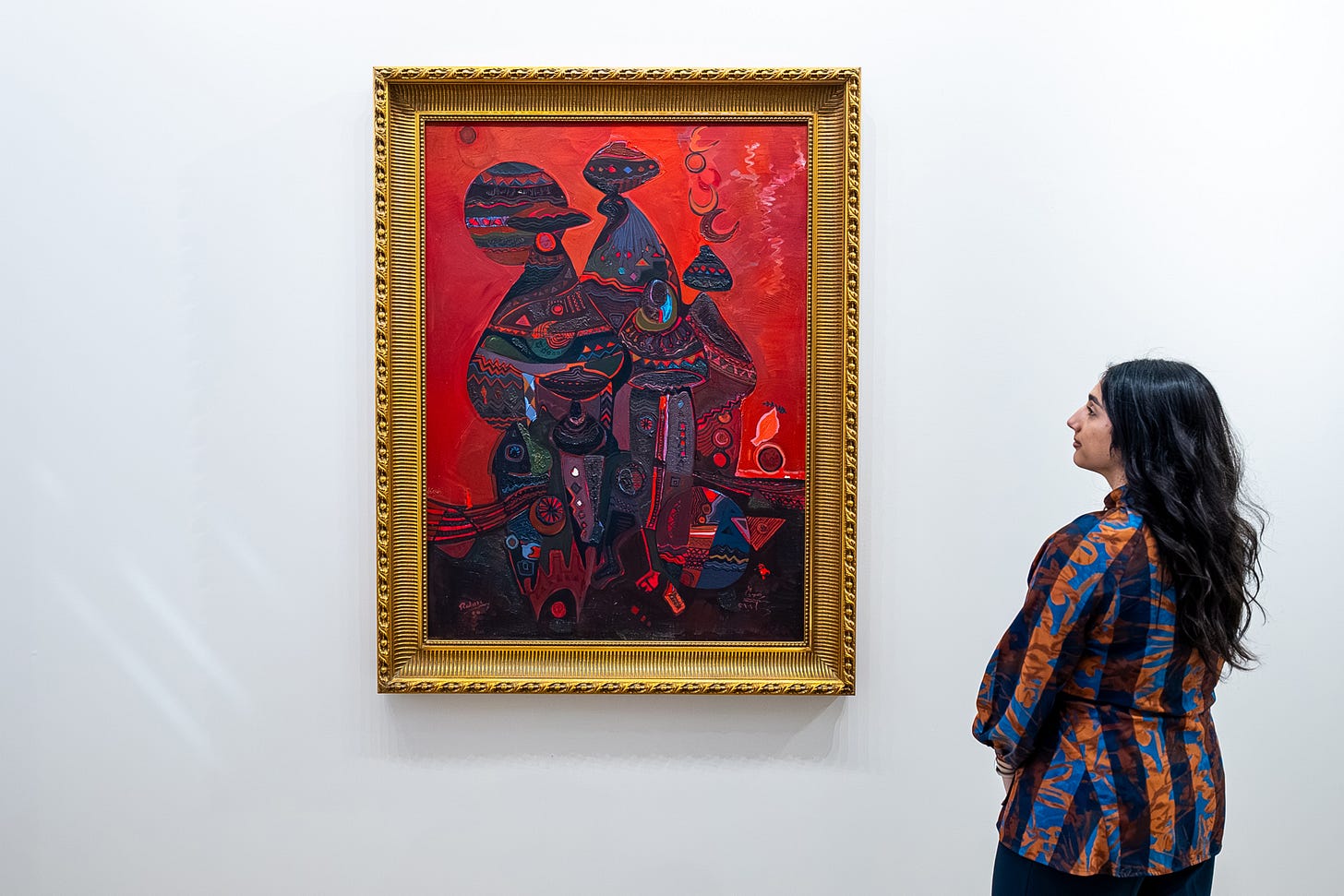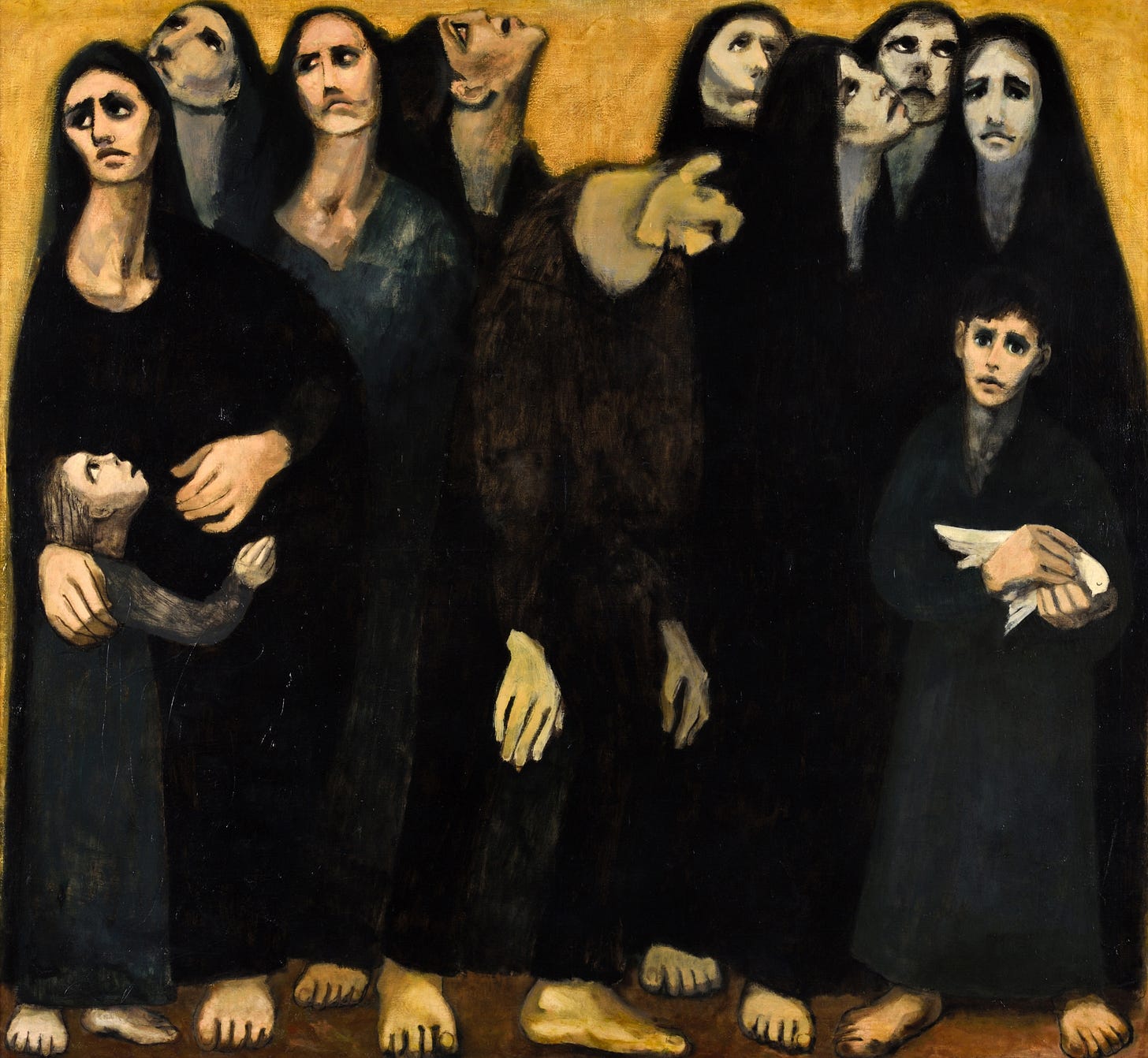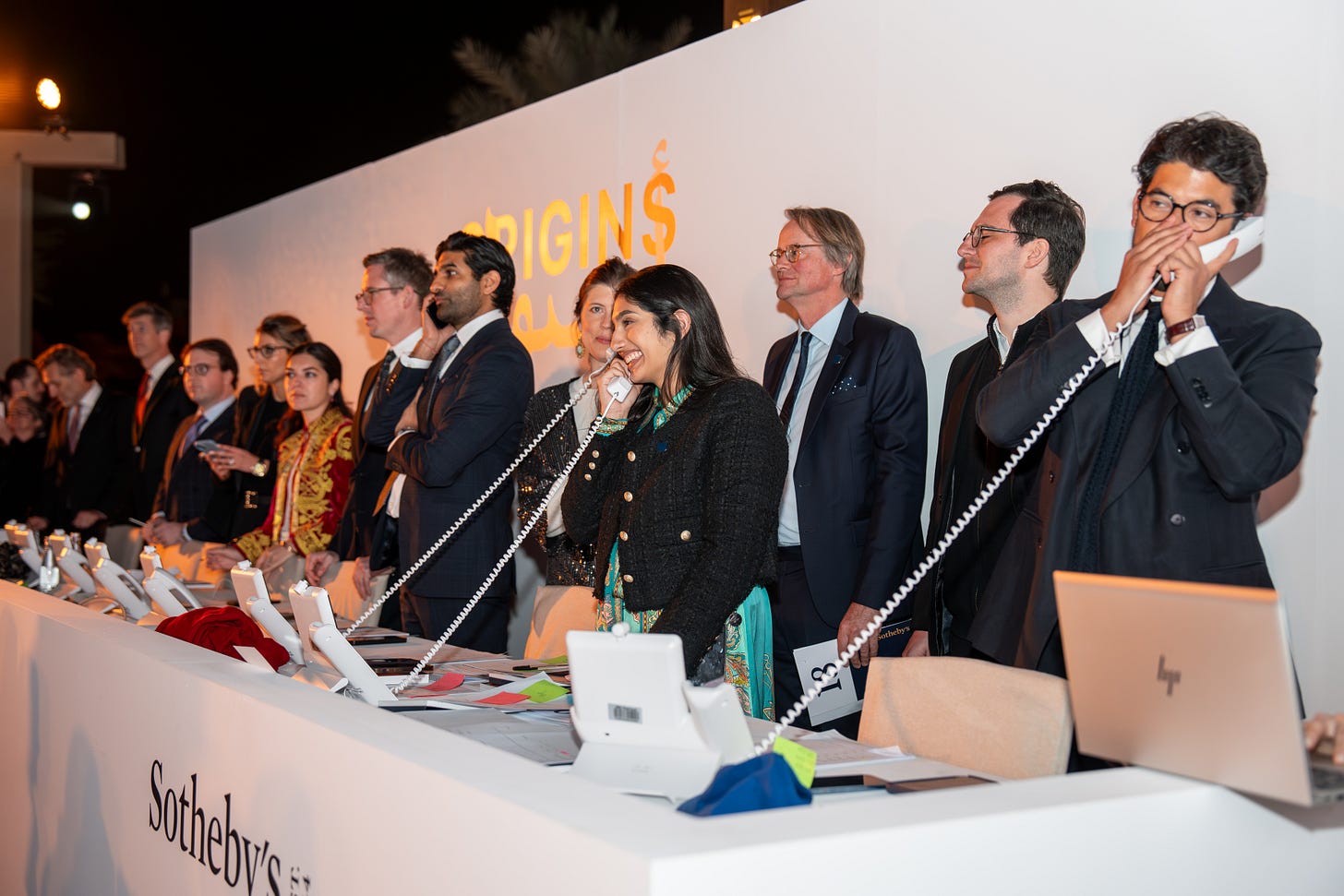Saudi Arabia hosts its first Sotheby's auction - here's why it matters
And one of my favourite paintings by an Arab artist sold for a record price
The first Sotheby's auction in Saudi Arabia took place this weekend and to say it was a big deal would be an understatement.
After a week-long free exhibition entitled Origins which featured up to 100 pieces, including digital art and luxury items and paintings from both international and regional artists, the auction results reveal an interest and demand for modern and contemporary Arab art.
The total sale of the auction reached $17,283,840. Almost a third of the works were sold to buyers from within the Kingdom. And, of those who registered to bid on works, 30% of them were under the age of 40 – young people wanting to buy art - Arab art? This to me is particularly exciting.
This a huge win not only for Saudi Arabia but for the regional art scene from both an infrastructure perspective and historical archival standpoint.
So, let’s list down what happened and what it all means.
The International Section
While exciting, it’s no surprise that there was great interest from regional and international buyers for works by renowned contemporary artists and recognised masters.
Fleurs from 1948 by Pablo Picasso sold at $204,000: This striking work on paper sold for more than three times its initial estimate. Again, this doesn’t surprise me, people will always pay more for a work by a master of Picasso’s stature.
The Light Underneath by James Turrell sold at $660,000: Turrell, who is known for his light installations similar to this work, is also planning a monumental work in AlUla. It will be interesting to see what he does there.
Machine Hallucinations, Space by Refik Anadol sold for $900,000: The digital work by the Turkish-American visual artist sold for is really an incredible piece that also incorporates AI technology.
Society Woman by Fernando Botero sold for $1 million: In case you didn’t know, Botero is the artist who painted Pope Leo X in 1964 which became the foundation for the Y Tho meme one of the world’s most popular meme’s (and my screen saver).
Subject to Availability by Banksy sold for $1.2 million: From his Vandalised Oil’s series - it’s Banksy, which will always do well.
L'État de veille by René Magritte sold for $1.2 million: the gouache on paper work by the Surrealist artist it really stunning.
Modern and Contemporary Arab Art
Saudi artists did exceptionally well in the auction with a variety of artists represented in various styles and mediums.
Magadeer (from Food for Thought) by Maha Malluh sold for $84,000: the 2024 sculpture sold for above its estimate. The sculptural piece examines the the cultural symbols of Saudi Arabian civilization and is also influenced by Malluh’s spiritual connection to the historic region of Najd.
Illumination Diptych (Makkiah Tale) by Ahmed Mater sold for $102,000: executed in 2012, this work also exceeded its estimate. Mater is an incredibly important artist whose works have been collected and exhibited across the region and internationally.
Untitled by Abdulhalim Radwi sold for $264,000: The 1984 work sold at a record price is a vibrant painting depicting three female figures in a market place with traditional folklore elements in a palette of rich reds, blues, and purples.
O' God, Honor Them and Do Not Honor an Enemy Over Them by Mohammed Al Saleem sold for $660,000: : Painted in 1977, the work tripled its initial estimate. The painting exemplifies Al Saleem’s style known as horizonism, which combines the desert landscape, Arabic calligraphy and urban city elements, fusing traditional and modern aesthetics.
Outside of Saudi, really significant works of Arab art were also sold at impressive prices – and rightfully so.
Blue Trap (in a Railroad Station) by Samia Halaby sold for $384,000: The renowned Palestinian-American artist painted this piece in the 1970s. It was inspired by the optical visuals seen by Halaby when she traveled at high speed from New Haven to New York.
Secret of the Cube by Saloua Raouda Choucair sold for $144,000: executed in 1977, this piece is one of Choucair's only early wood sculptures to appear on the market.
Untitled (Deserts Series) by Aref El Rayess sold for $108,000: The 1982 work was executed during El Rayess’ time living away from Lebanon and in Saudi Arabia where depicted the desert landscape in its essence.
However, the jewel of the auction, and one of my favourite works ever, broke a record for the Arab artist.
Then What?? by Louay Kayyali sold for $900,000
After an intense bidding battle the powerful work Then What?? by the Syrian artist Louay Kayyali sold for $900,000. The sale set a new record for a Kayyali piece.
Painted in 1965, Then What?? is a masterpiece. I don’t use that word lightly.
The work is grand in size and Kayyali’s compositions of the 11 figures is incredible. Nine women and two children all dressed in black with sombre elongated faces, painted with expressive brushstrokes, stand against a mustard yellow background. The contrast of colour emphasises the figures garbs as well as their tortured expressions.
Kayyali’s arranged these figures in two groups on each side of the frame, with their postures and gazes leading the viewer across the painting until our eyes fall on the only figure staring out at us.
The young boy holds a dove which appears to be dead, his large hands cupping it as its wing rests lifeless over his wrist.
That image alone is poignant and then within the context of the rest of the work, Kayyali created a powerful image that is hard to forget.
Then What?? is a reference to Palestinian exile and was painted two years prior to the Six-Day War, revealing not only Kayyali’s understanding of the regional political climate but his commitment to depict human struggles and social issues through figurative pieces.
What does this mean for the region?
The biggest take away for me from the results of the auction is the continued growing focus and tangible interest in Arab art.
Yes, pieces by both Arab modern masters and contemporary artists were recognised as valuable assets in the global art market, but this is more than a financial win.
This is a celebration of local and regional talent and another step toward the cultural evolution in the region. It’s part of a much larger movement where the focus on heritage and identity is moving beyond traditional Islamic art and architecture, mediums the region has always been globally praised for.
Attention now is being given to the diverse artistic expressions, including abstract and conceptual works, that inform swaths of significant historical narratives in the region.
Like the work of Kayyali – a deeply important artist and art work - these works says something about a time, place and people that no news story history book can aptly describe.
The recognition of these artists, their stories, their works and the narratives they are part of need to archived and valued until they become part of mainstream culture not only in the Arab world but on the global stage.








